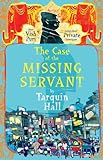Part 2 of my report on the
RUSA sponsored
presentation, "
Things That Go Bump in the Stacks: Whole Collection Readers' Advisory for Paranormal Fiction," will focus on what the authors on the panel had to say. (
Click here for part 1)
Just real quick, in case you didn't use the links to each author's home page in the previous post here they are again.
Charlie Huston writes
noir fiction. His paranormal series follows
vampyre Joe Pitt in
NYC's underworld.
Marjorie Liu writes paranormal romances and thrillers with
international settings and ethnic or
multiracial characters. As she said, her books have just about any kind of paranormal creature in them. And finally, unless you are living under a rock, you should know who
Charlaine Harris is.
The moderator, Neil Hollands, gave each author a chance to begin with a general comment of their use of the paranormal in their novels.
Liu began by describing her
Hunter Kiss series. She said that she throws in a lot of paranormal in order to hit many appeal points for her readers. But the key, she said, at least for her readers, is that she merges adventure and romance with the paranormal.
Huston talked about
Joe Pitt, his
vampyre, fixer for hire in
NYC's underworld. He says that his readership skews male and leans toward, "the socially
alienated disaffected young man." He also noted that although their is a romance elements to the Pitt books, they are not romances in any way. He said he
basically writes hard boiled, pulp
noir novels, that have a paranormal element. He also wanted to make it clear that he has a dirty mouth and that these are "vulgar" books with lots of "splatter," and f-bombs.
Harris used her first chance to speak to talk about how her books sound milder on paper than they read, and they have "naive" cover art, which betrays the violence and seriousness found in the pages between the covers. She described the
Sookie Stackhouse books as romantic and hard boiled. She also said of paranormal fiction in general that since the offering can run the gamut of appeal to readers, this becomes both the charm and the weakness of the field right now.
Holland's first questions to the panel was: Who are your readers? What appeals to them about the paranormal? And, how can librarians steer them to you books?
Huston is alarmed by what he called, "too young readers." But then he thinks about what he read as a teenager and feels a bit better; his choices were very inappropriate and he turned out fine. His readers again tend to be the "disaffected young males," but he has, as he put it, "readers all over the gender map." He also commented on a 71 year old reader for whom the Joe Pitt books inspired him to go back to writing his own poetry.
Harris said you can tell a lot about why the
Sookie books appeal to her readers based on what part of
Sookie's problems they are interested in. For example, some are fixated on who
Sookie will end up with
romantically; others are focused on who she
should be with, and still others are most concerned about
Sookie's larger
personal growth. I found this comment very useful as an RA; now I will be able to better gauge what readers like about Harris' books and steer them to their next good read all the more
accuratelyHarris also wanted to point out that although her books are fun to read, they do have an overarching message about the acceptance of people's differences. If you don't get the message as a reader, she is also fine with that, but that message of tolerance is there, and readers really enjoy that aspect. (For the record, I am one of those readers)
Liu listed her main themes as tolerance and
faith in yourself and others as something her readers seem to enjoy. And again, she agreed with the other authors that she does find that her more mature books do have some too young readers.
Hollands then asked the panel to comment on their use of real world issues in their paranormal novels.
Huston said he didn't mean to do this, but he found when he chose to write about an underground culture of
vampyres that needs to hide, there were different political views that emerged within that culture. For instance, there are those who claim their culture needs to hide from the regular world, while other argue that they
should try to
pass in the larger world, and still others who are searching for a "cure" for their
vampyre-
ness. He also said that as a writer of fiction, what you write is always informed by the real world.
Hollands then made the observation to Harris (and to many chuckles from the
knowledgeable group) that she sure puts
Sookie through a lot in the books. Did you realize that would happen, and is it getting harder to write the
Sookie books now?
Harris began her answer with one of her favorite stories. It took her agent 2 years to sell the first
Sookie book, so Harris did not really plan out the series because there was no sign that she would ever get to publish even the first book. Once the first book was finally published, it won the
2002 Anthony Award for best paperback mystery. While on stage
accepting her award, Harris saw all of the editors who passed on
Sookie (some with not very nice comments), and she briefly considered sticking it to them, but instead took the high road.
So, she repeated, she has not outlined this series. She just sits down and writes them. She said she is in a contest with
Jim Butcher over who can take more punishment in their books,
Sookie or
Harry Dresden. After the last
Sookie book, Butcher emailed her that
Sookie may be winning. She also apologized for
killing Sookie's Gran in the first book, but, she also told us, "Gran had to go for
Sookie to have any kind of sex life." So far, Harris noted, people seem fine with
Sookie getting a major blood transfusion in each book, as long she she keeps going.
Hollands then turned to Huston and commented that Joe Pitt is a nasty man, driven by anger, yet somehow this awful person seems sympathetic. Are you trying to do that?
Huston laughed and said, "Neil, the fact that you find Joe Pitt sympathetic says a lot about you." But seriously, Huston reminded the librarians in the audience that Pitt is not the vampire who just kills pigs or bad guys to get the blood he needs, he also kills innocent people. Also, Pitt is not sympathetic to all readers. He is first and
foremost a hard-boiled
detective who people hire to get a job done; to keep their own hands clean. Huston commented that he actually tries to
write Pitt as
unsympathetically as possible, but more often than not, Pitt does kill the people who need to be killed.
Hollands brought up a new line of discussion by saying, "readers have to suspend a certain amount of disbelief to get going with a paranormal story."
Harris jumped in on this one with comments that I loved. For any fictional form, she said, you cannot completely and accurately recreate reality. It is still fiction. So, she does not see her work as any less realistic than any other fiction. "I write books that are
entertaining and a little bit disturbing. People need that."
Liu agreed, noting that as a writer it is your job to sell your story no matter how unrealistic it is.
And
Huston added that, "I didn't write vampire books to get non-vampire fans to read it." Which led him to talk about the fact that he never gets comments by his vampire loving fans about getting anything in the vampire world wrong, but he does get tons of comments when he describes a NYC subway station wrong. Also, he had an editor that wanted to take all of the scenes where Pitt is smoking in a bar out of the latest book because you can no longer smoke in NYC bars. Huston refused because as a hard-boiled
detective, Pitt needs to smoke
where ever and whenever he wants. This led him to comment, "you can get over the vampire stuff just fine, but the smoking in bars is a problem?"
Hollands asked the authors what books they think are most similar to their own?
Huston began by stating again that the Joe Pitt books are really
noir/
hard-boiled stories, so he thinks that
James Ellroy and
Raymond Chandler are the most similar to the Pitt books. He admitted that he really does not read much paranormal stuff himself.
Harris writes quite a bit about what she is reading on
her blog. She said she wants to steer people to good books and she will note the violence level in her reviews. But she thinks that the works of
Patricia Briggs and
Kim Harrison are good bets for
Sookie fans.
Liu suggested reading
Emma Bull,
Charles de Lint for good urban fantasy, and
Christine Feehan and
Sherrilyn Kenyon for paranormal romance.
Hollands then let the group know that
Liu, along with other paranormal writers, was featured in the May 2009 issue of Locus Magazine giving
recommendations of their favorite paranormal writers.
Hollands let each author wrap up by telling us what was coming up for them.
Huston told the group that
the final Joe Pitt novel will be coming out in October. It will have "lots of death." In January or February he will publish
Sleepless which is not paranormal, but is a speculative crime story.
Harris will publish a collection of previously published
Sookie stories in October. She is currently writing
Sookie 10 and is in the process of signing a contract for 3 more
Sookie books. She is also part of an upcoming compilation called
Death's Excellent Vacation, which will have stories of paranormal characters on...you got it, vacation.
Liu will have a story in a collection of feminist fairy tales called
Never After coming out this fall.
That was the end of the formal program. Overall, I found this
presentation extremely
informative and helpful. I will use much of what I heard here to help many different patrons.
Thanks to all of the authors for agreeing to appear in front of a group of librarians at 10:30 am on a Sunday morning. Also, thanks to Neil Hollands and
RUSA for putting the program together.
 I have been reading a lot of mysteries lately; here's another one.
I have been reading a lot of mysteries lately; here's another one.













